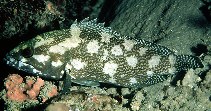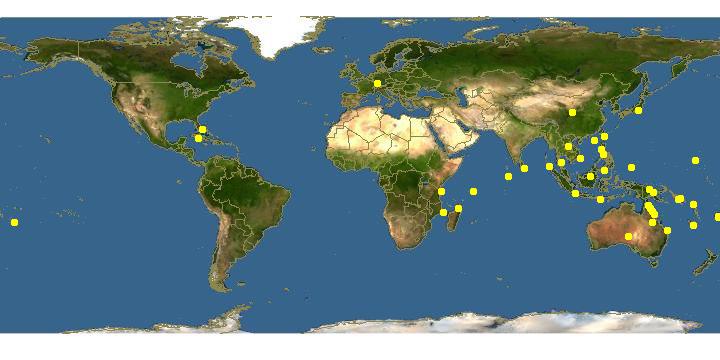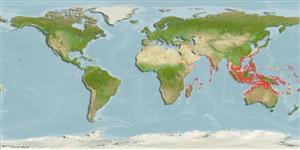http://www.fishbase.org/Summary/speciesSummary.php?genusname=Epinephelus&speciesname=ongus ---> http://192.134.151.83/Summary/speciesSummary.php?genusname=Epinephelus&speciesname=ongus
http://192.134.151.83/Summary/speciesSummary.php?genusname=Epinephelus&speciesname=ongus ---> https://fishbase.mnhn.fr/Summary/speciesSummary.php?genusname=Epinephelus&speciesname=ongus
https://fishbase.mnhn.fr/Summary/speciesSummary.php?genusname=Epinephelus&speciesname=ongus ---> https://fishbase.mnhn.fr/summary/Epinephelus-ongus.html
Epinephelus ongus, White-streaked grouper : fisheries

You can
sponsor
this page
Common name (e.g. trout)
Genus + Species (e.g. Gadus morhua)
-

-
About this page
-
Languages
-
User feedbacks
-
Citation
-
Uploads
-
Related species
-


 White-streaked grouper
Add your observation in
Fish Watcher
Upload your
photos
and
videos
White-streaked grouper
Add your observation in
Fish Watcher
Upload your
photos
and
videos
Pictures
|
Videos |
Google image
 Epinephelus ongus
Epinephelus ongus
Picture by
Randall, J.E.
Teleostei (teleosts) >
Perciformes/Serranoidei
(Groupers) >
Epinephelidae
(Groupers)
Etymology:
Epinephelus:
Greek, epinephelos = cloudy (Ref.
45335
)
.
More on author:
Bloch
.
Environment: milieu / climate zone / depth range / distribution range
Ecology
Marine; brackish; reef-associated; depth range 20 - 60 m (Ref.
89707
). Tropical; 36°N - 27°S, 31°E - 179°W (Ref.
5222
)
Indo-West Pacific: East Africa to the Ryukyu Islands, Marshall Islands, Fiji, New Caledonia, and northern Australia. Recently recorded from Tonga (Ref.
53797
). Reported from Somalia and India by Heemstra & Randall in 1984 but valid records and specimens have not been found (Ref.
4787
). Closely related to
Epinephelus summana
known only from the Red Sea.
Length at first maturity / Size / Weight / Age
Maturity: L
m
?
, range 16 - ? cm
Max length : 40.0 cm TL male/unsexed; (Ref.
27362
)
Dorsal
spines
(total): 11;
Dorsal
soft rays
(total): 14-16;
Anal
spines
: 3;
Anal
soft rays
: 8. This species is distinguished by the following characters: body depth 2.7-3.2 in SL; head length 2.3-2.5 in SL; head pointed, flat interorbital area, dorsal head profile slightly convex; preopercle rounded, serrae small and mostly covered by skin; upper edge of operculum strongly convex, the rear edge almost vertical, the upper spine extending posterior to lower spine; rear nostril diameter about twice that of anterior nostril; small, embedded scales on maxilla; 2-4 rows of small teeth at midlateral part of lower jaw; canines at front of jaws small or absent; gill rakers of first gill arch 8-10 + 15-18 (including 6 to 8 rudiments on each limb); caudal fin rounded; pectoral fins large and fleshy, with 15-17 rays, the fin length 1.4-1.7 in HL; short pelvic fins, 1.9-2.4 in HL; lateral-line scales 48-53; lateral scale series 95-110. Colour of body brown, with numerous small white spots (in specimens >10 cm SL), horizontally elongate and tend to form wavy white lines in adults, several round or irregular pale blotches (eye-sized or larger) usually superimposed over small white spots, head brown, with numerous small white spots dorsally behind eyes; black maxillary streak usually hidden by maxilla, median fins with small white spots and streaks, the posterior margin blackish with a white edge, paired fins are greyish brown; juveniles of about 6 cm SL are brown, covered with small, dark-edged white spots which are round, except on front part of dorsal fin where they are elongated; white spots on paired fins become fewer and fainter with growth, and are absent in adults (Ref.
39231
,
89707
,
90102
).
Inhabits inner coastal and lagoon reefs, also in brackish waters where it occurs in ledges and caves (Ref.
5213
). Adults usually found deeper than 20 m (Ref.
48635
). Solitary (Ref 90102). Feeds on crustaceans and small fishes (Ref.
89707
). A cryptic species which is not very common, but of some interest to fisheries in Japan (and probably elsewhere). Caught with hook-and-line, spear, and traps (Ref.
39231
).
Life cycle and mating behavior
Maturity
|
Reproduction
|
Spawning
|
Eggs
|
Fecundity
|
Larvae
Heemstra, P.C. and J.E. Randall
, 1993. FAO Species Catalogue. Vol. 16. Groupers of the world (family Serranidae, subfamily Epinephelinae). An annotated and illustrated catalogue of the grouper, rockcod, hind, coral grouper and lyretail species known to date. Rome: FAO. FAO Fish. Synop. 125(16):382 p. (Ref.
5222
)
IUCN Red List Status (Ref.
130435
)
Least Concern (LC)
; Date assessed:
22 November 2016
CITES
Not Evaluated
Not Evaluated
Threat to humans
Harmless
Human uses
Fisheries: minor commercial
FAO - Publication:
search
|
FishSource
|
More information
Countries
FAO areas
Ecosystems
Occurrences
Introductions
Stocks
Ecology
Diet
Food items
Food consumption
Ration
Common names
Synonyms
Metabolism
Predators
Ecotoxicology
Reproduction
Maturity
Spawning
Spawning aggregation
Fecundity
Eggs
Egg development
Age/Size
Growth
Length-weight
Length-length
Length-frequencies
Morphometrics
Morphology
Larvae
Larval dynamics
Recruitment
Abundance
BRUVS
References
Aquaculture
Aquaculture profile
Strains
Genetics
Electrophoreses
Heritability
Diseases
Processing
Nutrients
Mass conversion
Collaborators
Pictures
Stamps, Coins Misc.
Sounds
Ciguatera
Speed
Swim. type
Gill area
Otoliths
Brains
Vision
Tools
Bio-Quiz
|
E-book
|
Field guide
|
Identification keys
|
Length-frequency wizard
|
Life-history tool
|
Point map
|
Classification Tree
|
Catch-MSY
|
Special reports
Check for Aquarium maintenance
|
Check for Species Fact Sheets
|
Check for Aquaculture Fact Sheets
Download XML
Summary page
|
Point data
|
Common names
|
Photos
Internet sources
AFORO (otoliths) |
Alien/Invasive Species database
|
Aquatic Commons
|
BHL
|
Cloffa
|
BOLDSystems
|
Websites from users
|
Check FishWatcher
|
CISTI
|
Catalog of Fishes
:
genus
,
species
|
DiscoverLife
|
ECOTOX
| FAO - Publication:
search
|
Faunafri
| Fishipedia |
Fishtrace
| GenBank:
genome
,
nucleotide
|
GloBI
|
Google Books
|
Google Scholar
|
Google
| IGFA World Record |
MitoFish
|
National databases
|
Otolith Atlas of Taiwan Fishes
|
PubMed
|
Reef Life Survey
| Socotra Atlas |
Tree of Life
| Wikipedia:
Go
,
Search
| World Records Freshwater Fishing |
Zoological Record
Estimates based on models
Preferred temperature (Ref.
123201
): 24.5 - 28.6, mean 27.8 °C (based on 320 cells).
Phylogenetic diversity index (Ref.
82804
): PD
50
= 0.5000 [Uniqueness, from 0.5 = low to 2.0 = high].
Bayesian length-weight: a=0.01148 (0.00756 - 0.01743), b=3.02 (2.90 - 3.14), in cm total length, based on LWR estimates for this species & Genus-body shape (Ref.
93245
).
Trophic level (Ref.
69278
): 4.0 ±0.66 se; based on food items.
Generation time: 3.3 ( na - na) years. Estimated as median ln(3)/K based on 1
growth studies.
Resilience (Ref.
120179
): Medium, minimum population doubling time 1.4 - 4.4 years (K=0.3).
Fishing Vulnerability (Ref.
59153
): Low to moderate vulnerability (33 of 100).
Price category (Ref.
80766
):
Very high
.
Nutrients (Ref.
124155
): Calcium = 34.8 [15.3, 69.1] mg/100g; Iron = 0.518 [0.272, 1.055] mg/100g; Protein = 18.8 [17.3, 20.3] %; Omega3 = 0.145 [0.089, 0.233] g/100g; Selenium = 30.7 [17.2, 57.6] μg/100g; VitaminA = 189 [46, 791] μg/100g; Zinc = 1.53 [1.03, 2.15] mg/100g (wet weight);
Back to Search
Random Species
Back to Top
Accessed through:
Not available
FishBase mirror site :
localhost
Page last modified by :
mrius-barile
- 20 July 2016
Fatal error
: Uncaught ArgumentCountError: Too few arguments to function checkEcotox(), 1 passed in /var/www/html/summary/speciessummary.php on line 2304 and exactly 3 expected in /var/www/html/includes/speciessummary.lib.php:2579 Stack trace: #0 /var/www/html/summary/speciessummary.php(2304): checkEcotox() #1 {main} thrown in
/var/www/html/includes/speciessummary.lib.php
on line
2579
|






